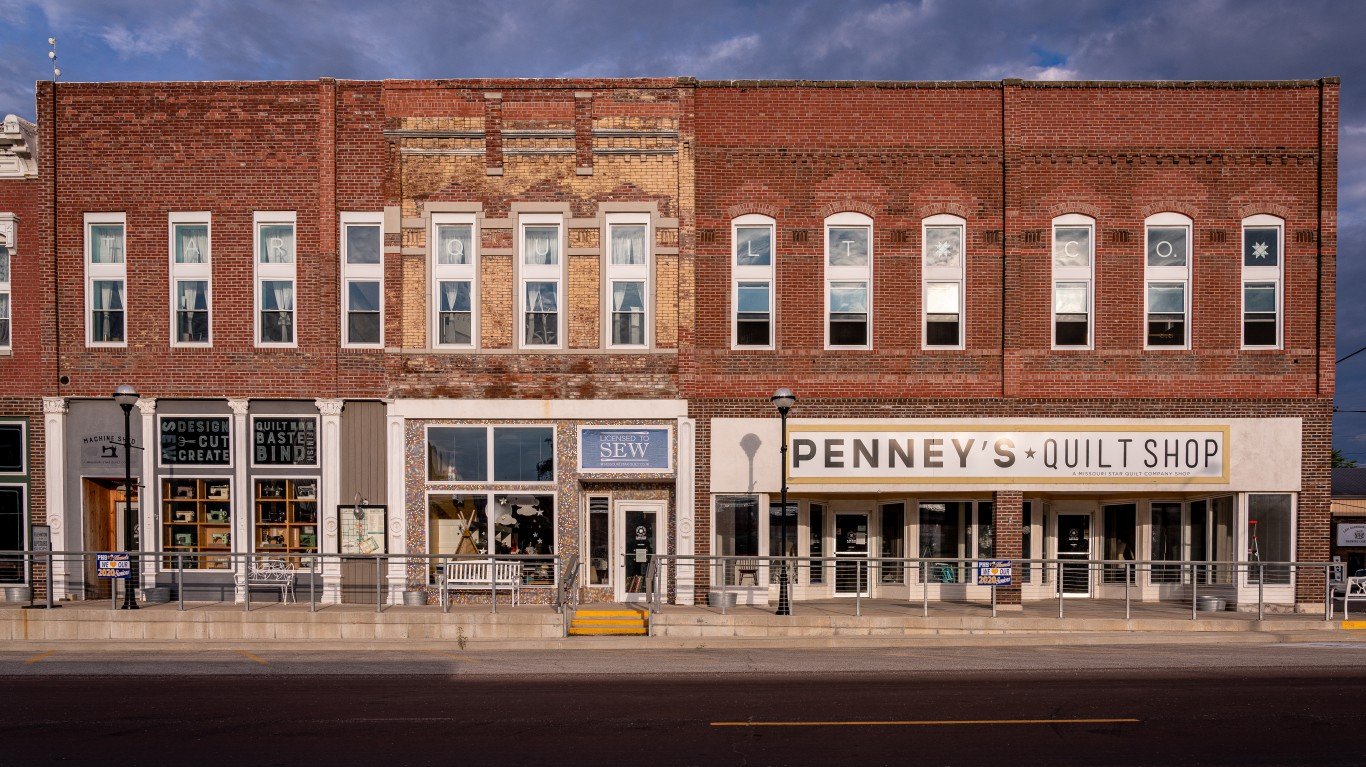

President Joe Biden made history in February when he announced his nomination of Judge Ketanji Brown Jackson for the Supreme Court, following through on a campaign promise to nominate a Black woman for the position. If confirmed, Jackson would be the sixth ever female Supreme Court Justice.
Though this represents a major step forward in the history of the country, the reality is that women are still at a disadvantage in many aspects of life in the U.S. Female workers have a median income that is much lower than the median income for men. Women are also much less likely to hold key political offices, and many face significant health challenges that need to be addressed. While these issues are prevalent across the country, the disparity and disadvantages are much larger in some states than others.
To determine the worst states for women, 24/7 Wall St. developed an index composed of 15 metrics measuring economy, health, and leadership in all 50 states.
Many of the worst states for women are located in the South, while the Northeast accounts for the vast majority of the best states for women, with states in the West and Midwest ranking anywhere from top to bottom.
Though no state has achieved gender pay equity, many have made progress in closing the earnings gap and improving in other areas, such as funding pre-K programs, passing laws that make it easier for women to stay in the workforce when they have children, and electing women to office. Still, even in high-paying jobs in science and management fields women are still generally paid less for the same work. These are the highest paying jobs for women (that still pay men more).
Click here to see the worst states for women
Click here to read our detailed methodology

1. Connecticut
> Female earnings as pct. of male earnings: 97.0% (the highest)
> Female life expectancy at birth: 82.9 years (3rd highest)
> Pct. legislative seats held by women: 34.2% (16th highest)
> Pct. mgmt. jobs held by women: 40.4% (14th lowest)
Connecticut ranks as the best state for women, as female residents are relatively healthy and on nearly equal financial footing as male residents. Female workers have a median annual earnings of $60,632, the highest of all states. That median is 97% of what male workers earn, the smallest gender wage gap of any state. Nationwide, female workers earn 82.3% of what male workers do.
Women in Connecticut report relatively positive health outcomes, with a life expectancy at birth of almost 83 years, the third highest among all states. The state also has one of the lowest rates of infant deaths, at 4.4 per 1,000 births, and one of the highest rates of female health insurance coverage, at 95.2%. Both rank among the top 10 among all states.
[in-text-ad]

2. New York
> Female earnings as pct. of male earnings: 84.5% (11th highest)
> Female life expectancy at birth: 82.8 years (4th highest)
> Pct. legislative seats held by women: 28.6% (19th lowest)
> Pct. mgmt. jobs held by women: 43.5% (7th highest)
New York’s health care system and laws help make it one of the best states for women. The state has laws that mandate paid sick leave, paid family leave, and expanded eligibility for coverage of family planning services under Medicaid. New York is one of just six states with all three guaranteed.
Women in New York are much more likely to hold a bachelor’s degree than the typical American woman. An estimated 39.0% of adult women in New York hold at least a bachelor’s degree compared to just 33.9% of all women in America aged 25 and older.
3. New Jersey
> Female earnings as pct. of male earnings: 82.2% (21st highest)
> Female life expectancy at birth: 82.3 years (7th highest)
> Pct. legislative seats held by women: 30.0% (24th lowest)
> Pct. mgmt. jobs held by women: 39.7% (9th lowest)
Female workers in New Jersey earn 82.2% of what male workers do, roughly in line with the nationwide gender wage gap. However, the median annual wage for female workers is $7,800 higher in the state than it is across the U.S., at $54,132.
Much of what makes New Jersey one of the best states for women comes in the form of legislation and investment in women and families. The state spends over $14,000 per child enrolled in preschool – by far the highest total of any state. More than a quarter of New Jersey 3- and 4-year-olds are in Pre-K, compared to 20% of American children. New Jersey is also one of six states with mandatory sick leave, parental leave, and expanded eligibility for coverage of family planning services under Medicaid.

4. Massachusetts
> Female earnings as pct. of male earnings: 82.2% (20th highest)
> Female life expectancy at birth: 82.5 years (6th highest)
> Pct. legislative seats held by women: 31.0% (23rd highest)
> Pct. mgmt. jobs held by women: 43.7% (6th highest)
Women in Massachusetts report among the best health outcomes in the country. The above average health outcomes help make the New England state one of the best states for women in the country. Almost 98% of female Massachusetts residents have health insurance, the highest share of any state. Massachusetts has the sixth-highest female life expectancy at 82.5 years. It also has the second-lowest infant mortality rate in the country, at 3.7 deaths per 1,000 live births.
In Massachusetts, 45% of women 25 and older hold at least a bachelor’s degree, by far the highest share of any state. A college degree can help open the door to a wide variety of high-paying jobs, and female workers in Massachusetts have the second-highest income among all states, at nearly $58,000 per year. The state also has one of the highest shares of management jobs held by women, at 43.7%.
[in-text-ad-2]

5. Maryland
> Female earnings as pct. of male earnings: 86.1% (7th highest)
> Female life expectancy at birth: 81.1 years (25th lowest)
> Pct. legislative seats held by women: 40.4% (10th highest)
> Pct. mgmt. jobs held by women: 47.1% (2nd highest)
Maryland ranks as the fifth-best state for women and the best state outside of the Northeast region. The median annual earnings for women in Maryland is $55,848, the third-highest median for female workers of all states. That represents 86.1% of male earnings, the seventh-smallest gender wage gap among states.
Maryland is one of just 10 states in which more than 40% of legislative seats are held by women in the state legislature. Women also have 47.1% of all management jobs in the state, the second highest share among all states.

6. Rhode Island
> Female earnings as pct. of male earnings: 85.5% (9th highest)
> Female life expectancy at birth: 82.2 years (9th highest)
> Pct. legislative seats held by women: 45.1% (3rd highest)
> Pct. mgmt. jobs held by women: 46.2% (3rd highest)
Rhode Island ranks as one of the top states for women largely because female workers tend to have relatively high earnings. The median annual earnings for female workers in the state is $49,452, more than $3,000 higher than is typical nationwide. Though this is still 14.5% lower than the median annual earnings for male workers, that is one of the 10 smallest gender wage gaps in the U.S.
Positions of power in Rhode Island are nearly evenly split between men and women. Women account for more than 45% of the seats in the state legislature and more than 46% of all management positions. Both shares rank as the third highest among states.
[in-text-ad]

7. California
> Female earnings as pct. of male earnings: 87.6% (2nd highest)
> Female life expectancy at birth: 83.1 years (2nd highest)
> Pct. legislative seats held by women: 33.3% (17th highest)
> Pct. mgmt. jobs held by women: 41.8% (21st highest)
California is the West Coast’s top state for women. The state has the second-lowest gender wage gap among all states. Female workers in California earn a median of $51,636 per year – 87.6% of what male workers earn.
California’s health outcomes and laws also help make it one of the best states for women. California women have the second-highest life expectancy at birth, at over 83 years. The state also offers mandatory sick leave, parental leave, and expanded eligibility for coverage of family planning services under Medicaid.

8. Vermont
> Female earnings as pct. of male earnings: 83.7% (16th highest)
> Female life expectancy at birth: 81.7 years (12th highest)
> Pct. legislative seats held by women: 41.5% (8th highest)
> Pct. mgmt. jobs held by women: 44.1% (5th highest)
Women nationwide tend to be slightly more likely to have college degrees than men – 33.9% to 32.3% – but the gap is much more pronounced in Vermont, with 42.0% of the state’s women aged 25 and older holding at least a bachelor’s degree, compared to just 35.2% of men. Vermont also has a smaller wage gap than in most other states, with female median annual earnings amounting to 83.7% of male earnings.
Vermont also has a relatively high share of women in leadership positions both in the public and private sectors. Women hold 41.5% of legislative seats in the state, the eighth highest share, and 44.1% of management jobs, the fifth highest share.

9. Oregon
> Female earnings as pct. of male earnings: 83.5% (17th highest)
> Female life expectancy at birth: 81.9 years (11th highest)
> Pct. legislative seats held by women: 42.2% (7th highest)
> Pct. mgmt. jobs held by women: 41.3% (24th lowest)
Oregon ranks as one of the best states for women in large part because of its high ranking in leadership measures. The state has had more female representation in government than the vast majority of other states. It is one of just 10 states to have had multiple female governors, including its current governor, Kate Brown. Women also hold 42.2% of state legislative seats, the seventh highest share in all states.
Oregon’s health outcomes for women also outpace those of most other states. The life expectancy at birth of female residents is nearly 82 years, ranking 11th out of all states. It is also one of just six states to mandate paid sick and family leave as well as expanded eligibility for family planning services under Medicaid.
[in-text-ad-2]

10. Washington
> Female earnings as pct. of male earnings: 80.2% (21st lowest)
> Female life expectancy at birth: 82.1 years (10th highest)
> Pct. legislative seats held by women: 41.5% (8th highest)
> Pct. mgmt. jobs held by women: 40.8% (17th lowest)
Though female workers in Washington tend to make relatively high wages, with median annual earnings just over $51,000, the state’s gender pay gap is larger than most, with female workers earning just over 80% of what male workers do. Still, Washington is one of the 10 best states for women, in large part because of the positive health outcomes.
Washington female residents have a life expectancy at birth of 82.1 years, which ranks as the 10th highest among all states. It also has the fifth-lowest infant death rate among states, at 4.3 per 1,000 live births. The nationwide rate is 5.6 per 1,000 live births.

11. Hawaii
> Female earnings as pct. of male earnings: 79.4% (14th lowest)
> Female life expectancy at birth: 84.0 years (the highest)
> Pct. legislative seats held by women: 32.9% (18th highest)
> Pct. mgmt. jobs held by women: 48.5% (the highest)
In no state do women hold a majority of management jobs, but in Hawaii they nearly do, holding 48.5% of these positions. This is well above the 41.4% of management jobs held by women nationwide.
Women in Hawaii tend to report among the best health outcomes in the U.S. The female life expectancy at birth in the state is 84 years, by far the highest of any state.
[in-text-ad]

12. Colorado
> Female earnings as pct. of male earnings: 78.1% (12th lowest)
> Female life expectancy at birth: 82.3 years (7th highest)
> Pct. legislative seats held by women: 46.0% (2nd highest)
> Pct. mgmt. jobs held by women: 39.9% (12th lowest)
Women in Colorado have among the highest educational attainment rates in the country. The bachelor’s degree attainment rate for female residents 25 and older is 43.5%, the second highest rate among all states and well above the 33.9% rate for all women.
Female Colorado residents also tend to report among the best health outcomes in the country, with a life expectancy at birth of 82.3 years – more than two years higher than the national expectancy.

13. Minnesota
> Female earnings as pct. of male earnings: 85.8% (8th highest)
> Female life expectancy at birth: 82.6 years (5th highest)
> Pct. legislative seats held by women: 34.8% (14th highest)
> Pct. mgmt. jobs held by women: 40.4% (13th lowest)
Minnesota ranks as the best state for women in the Midwest and the 13th best state overall. The state has the eighth lowest gender wage gap. Female workers earn 85.8% of what male workers do. Nationwide, the gender wage gap is 82.3%. Female workers in Minnesota have a median annual earnings of $51,168 – nearly $5,000 higher than the median annual wages for all female workers nationwide.
Female Minnesota residents also report among the best health outcomes in the U.S. The state’s female life expectancy at birth is 82.6 years, and its infant mortality rate is just 4.5 per 1,000 live births. Both figures rank among the 10 best in the nation. Minnesota is also one of just 10 states in which at least 95% of women have health insurance.

14. Maine
> Female earnings as pct. of male earnings: 76.6% (5th lowest)
> Female life expectancy at birth: 81.2 years (25th highest)
> Pct. legislative seats held by women: 43.5% (5th highest)
> Pct. mgmt. jobs held by women: 42.4% (16th highest)
Women in Maine hold a relatively high share of leadership positions – both in the public and private sector. Female legislators hold 43.5% of all seats in the state legislature, accounting for 81 seats in total. This is the fifth highest share in the country and well above the 30.6% of seats held by women nationwide. Janet Mills became the state’s first female governor in 2019, making Maine one of just nine states with a female governor.
Female workers in Maine hold 42.4% of management jobs in the state, a full percentage point above the nationwide rate. However, in spite of women holding a relatively high share of leadership positions, Maine has one of the largest gender wage gaps in the country. Female workers in the state earn 76.6% of what male workers earn.
[in-text-ad-2]

15. New Mexico
> Female earnings as pct. of male earnings: 87.5% (3rd highest)
> Female life expectancy at birth: 80.4 years (19th lowest)
> Pct. legislative seats held by women: 43.8% (4th highest)
> Pct. mgmt. jobs held by women: 42.7% (12th highest)
New Mexico has a higher share of women in leadership positions than nearly every other state. More than 42% of management jobs and more than 43% of legislative seats are held by women, both well above national rates. It is also one of nine states with a female governor, Michelle Lujan Grisham.
Median annual earnings are relatively low in New Mexico for both men and women. The state has one of the smallest gender wage gaps in the country, with female workers earning 87.5% of what male workers do.

16. Wisconsin
> Female earnings as pct. of male earnings: 86.5% (5th highest)
> Female life expectancy at birth: 81.6 years (14th highest)
> Pct. legislative seats held by women: 31.1% (21st highest)
> Pct. mgmt. jobs held by women: 42.1% (18th highest)
Wisconsin has one of the smallest gender pay gaps. Female workers in the state earn 86.5% of what male workers do, the fifth smallest difference in earnings.
Wisconsin women tend to have relatively good health outcomes. The state’s female life expectancy at birth is 81.6 years, compared to 81.2 years for all American women. Also, 95.3% of women in the state have health insurance, the eighth highest insured rate among women of all states in the country.
[in-text-ad]

17. New Hampshire
> Female earnings as pct. of male earnings: 82.5% (19th highest)
> Female life expectancy at birth: 81.5 years (17th highest)
> Pct. legislative seats held by women: 35.8% (12th highest)
> Pct. mgmt. jobs held by women: 40.5% (15th lowest)
New Hampshire ranks as a better state for women than most, as the health outcomes of the women in the state are among the best in the country. New Hampshire has by far the lowest infant death rate in the country, at 3.2 per 1,000 live births. The national rate is 5.6 deaths per 1,000 live births.
New Hampshire women also have a relatively high life expectancy at birth, at 81.5 years, and 94.5% of women in the state have health insurance. The state also has one of the highest bachelor’s degree attainment rates among female residents 25 and older, at 39.3%, the eighth highest in the nation.

18. Virginia
> Female earnings as pct. of male earnings: 79.5% (15th lowest)
> Female life expectancy at birth: 81.3 years (22nd highest)
> Pct. legislative seats held by women: 30.0% (24th lowest)
> Pct. mgmt. jobs held by women: 42.8% (10th highest)
Virginia ranks as a better state for women than most other states, despite many of its health and economic rankings roughly in line with U.S. figures. The state’s female life expectancy at birth is 81.3 years, compared to 81.2 years for all U.S. women. Virginia’s infant mortality rate of 5.8 deaths per 1,000 live births is just slightly higher than the U.S. rate, which is 5.6 deaths per 1,000 live births.
Though female workers in Virginia tend to have relatively high median annual wages, at over $52,000, the state has a relatively large gender wage gap. Women earn just 79.5% of what men do, compared to 82.3% nationwide.

19. Illinois
> Female earnings as pct. of male earnings: 80.1% (20th lowest)
> Female life expectancy at birth: 81.3 years (22nd highest)
> Pct. legislative seats held by women: 38.4% (11th highest)
> Pct. mgmt. jobs held by women: 41.1% (20th lowest)
Like many other states that rank toward the middle in conditions for women, Illinois has both positive and negative economic, health, and leadership indicators for female state residents. For instance, female workers in the state have a median annual earnings of $48,412 – more than $2,000 higher than the U.S. median. Yet this is just 80.1% of what men earn, a larger gender wage gap than in 30 other states.
Illinois has a relatively high share of legislative seats held by women, at 38.4%. Though this is well short of parity, it is still a higher share than in all but 10 other states. However, just 41.1% of management jobs in the state are held by women, compared to 41.4% of management jobs nationwide.
[in-text-ad-2]

20. Michigan
> Female earnings as pct. of male earnings: 80.6% (22nd lowest)
> Female life expectancy at birth: 80.1 years (14th lowest)
> Pct. legislative seats held by women: 35.8% (12th highest)
> Pct. mgmt. jobs held by women: 41.8% (20th highest)
Women occupy a relatively high share of leadership jobs in Michigan, compared to many other states. The state is one of just 16 states in which more than a third of legislature seats are held by women, and one of 10 that have had more than one female governor in their history, Including the current Gov. Gretchen Whitmer. Michigan also has a relatively high share of its management jobs held by women, at 41.8%.
Though female workers in Michigan have median annual earnings a few hundred dollars higher than the typical American female worker, the state has a larger gender pay gap than most others. American women earn about 82.3% of what men do. In Michigan, women earn just 80.6% of what men do.

21. Iowa
> Female earnings as pct. of male earnings: 83.7% (15th highest)
> Female life expectancy at birth: 81.6 years (14th highest)
> Pct. legislative seats held by women: 29.3% (21st lowest)
> Pct. mgmt. jobs held by women: 36.1% (5th lowest)
Though Iowa has a female governor, there are far fewer women in the state legislature than the average nationwide, at just 29.3%, compared to 30.6% of all state legislators. Women are also very unlikely to hold management positions in the private sector. Iowa has the fifth-lowest share of management jobs held by women, at 36.1%.
One of the main reasons why Iowa ranks 21st best for women is its health outcomes. The state’s female life expectancy at birth is the nation’s 14th highest, at 81.6 years. Iowa’s women also have the fifth-highest insured rate, at 96.0%
[in-text-ad]

22. Arizona
> Female earnings as pct. of male earnings: 86.4% (6th highest)
> Female life expectancy at birth: 81.5 years (17th highest)
> Pct. legislative seats held by women: 43.3% (6th highest)
> Pct. mgmt. jobs held by women: 42.4% (17th highest)
Arizona is unique in how frequently its voters have elected female representatives at multiple levels of government. It is the only state to have had at least four female governor’s throughout its history, and women hold 43.3% of all seats in the state legislature, compared to 30.6% of all seats in all 50 state legislatures.
Arizona also has the sixth smallest gender wage gap of any state, with female workers earning 86.4% of what men do, compared to 82.3% nationwide. In Arizona, 42.4% of management occupations are held by women, 1 percentage point higher than the share of management jobs held by women nationwide.

23. Pennsylvania
> Female earnings as pct. of male earnings: 79.6% (16th lowest)
> Female life expectancy at birth: 80.8 years (23rd lowest)
> Pct. legislative seats held by women: 28.9% (20th lowest)
> Pct. mgmt. jobs held by women: 41.1% (21st lowest)
Many of Pennsylvania’s financial, health, and leadership measures considered are roughly in line with overall U.S. rates, which is why the state ranks towards the middle of all states in best and worst states for women.
The earnings of Pennsylvania’s female workers are roughly in line with those of all U.S. female workers, ranking 20th overall. However, the state’s female workers earn less than 80% of what its male workers do.

24. Nebraska
> Female earnings as pct. of male earnings: 83.1% (18th highest)
> Female life expectancy at birth: 81.4 years (20th highest)
> Pct. legislative seats held by women: 26.5% (16th lowest)
> Pct. mgmt. jobs held by women: 35.3% (3rd lowest)
Nebraska is one of the best states in terms of investing in early education. The state spends nearly $9,000 per child enrolled in preschool, which ranks 10th among all states. Also, a quarter of children ages 3 and 4 are enrolled in a state prekindergarten, compared to 20% of all U.S. kids those ages. This investment can be beneficial for both children and parents.
However, Nebraska ranks towards the middle of the best and worst states for women because of its low performance in leadership measures. Female lawmakers and workers hold a relatively low share of the power in the state. Just 26.5% of legislative seats are held by women, compared to 30.6% across all states. Also, just 35.3% of management jobs are held by women, the third-lowest share in the country.
[in-text-ad-2]

25. Nevada
> Female earnings as pct. of male earnings: 79.8% (17th lowest)
> Female life expectancy at birth: 80.5 years (20th lowest)
> Pct. legislative seats held by women: 61.9% (the highest)
> Pct. mgmt. jobs held by women: 42.6% (14th highest)
Though Nevada does not rank as one of the best states for women, it has by far the highest share of legislative seats held by female representatives, at 61.9%. In no other state do women hold even half off all seats. However, the state has never had a female governor, though 31 other states have.
Nevada has one of the widest gender wage gaps in the country, as women earn less than 80% of what men do. The state also has a relatively low annual average income for women, at $41,132 – $5,200 lower than the median for all female workers in the U.S.

26. Florida
> Female earnings as pct. of male earnings: 84.1% (13th highest)
> Female life expectancy at birth: 81.6 years (14th highest)
> Pct. legislative seats held by women: 34.4% (15th highest)
> Pct. mgmt. jobs held by women: 41.6% (25th highest)
Florida ranks near the middle among the best states for women. Female workers make 84.1% of what male workers do. Yet the median annual wage for female workers is $43,212, more than $3,000 lower than the median earnings for a female worker nationwide.
The state’s health outcomes for female residents are a mixed bag. Florida women have a life expectancy at birth of 81.6 years, the 14th highest expectancy and 0.4 years ahead of the U.S. life expectancy for women. However, the state has a relatively high infant mortality rate, reporting 6.1 deaths per 1,000 live births. The infant mortality nationwide rate is 5.6 deaths per 1,000 live births.
[in-text-ad]

27. Kansas
> Female earnings as pct. of male earnings: 84.2% (12th highest)
> Female life expectancy at birth: 80.3 years (18th lowest)
> Pct. legislative seats held by women: 30.3% (25th lowest)
> Pct. mgmt. jobs held by women: 39.8% (10th lowest)
The gender wage gap in Kansas is one of the smallest in the country, with median annual earnings for female workers 84.2% of the median for male workers. Yet the median annual earnings for full-time female workers are more than $4,000 lower in Kansas than in the U.S. overall.
Women in Kansas occupy a relatively low share of leadership roles both in the state’s public and private sectors. Just 30.3% of legislative seats are held by women, slightly lower than the nationwide share. The state also has the 10th lowest share of management jobs held by women, at 39.8%.

28. Alaska
> Female earnings as pct. of male earnings: 80.9% (25th lowest)
> Female life expectancy at birth: 80.2 years (16th lowest)
> Pct. legislative seats held by women: 30.0% (24th lowest)
> Pct. mgmt. jobs held by women: 45.0% (4th highest)
Though median annual earnings of female workers in Alaska is relatively high, it is still less than 81% of what male workers in the state earn. Nationwide, female workers earn 82.3% of what male ones do.
Alaska has a relatively high gender pay gap in spite of the fact that women in Alaska hold 45% of management jobs, which tend to pay well. This is the fourth highest share in the country. Women’s life expectancy at birth in Alaska is 80.2 years – a full year below the U.S. life expectancy for women.

29. North Carolina
> Female earnings as pct. of male earnings: 81.1% (25th highest)
> Female life expectancy at birth: 80.2 years (16th lowest)
> Pct. legislative seats held by women: 25.9% (14th lowest)
> Pct. mgmt. jobs held by women: 41.3% (23rd lowest)
North Carolina ranks as a worse state for women than most others, in large part because of the poor health outcomes from female residents. The state’s female life expectancy at birth is 80.2 years – a full year lower than the average nationwide. North Carolina also has an infant mortality rate of 6.8 deaths per 1,000 live births. That is a higher rate than in all but a dozen other states.
Female workers in North Carolina earn 81.1% of what male workers in the state do and about $2,800 per year less than the typical female worker in the U.S.
[in-text-ad-2]

30. Texas
> Female earnings as pct. of male earnings: 87.0% (4th highest)
> Female life expectancy at birth: 80.8 years (23rd lowest)
> Pct. legislative seats held by women: 25.4% (12th lowest)
> Pct. mgmt. jobs held by women: 39.1% (8th lowest)
Though female workers in Texas have slightly lower median annual earnings than female workers nationwide, the state has one of the smallest gender wage gaps in the country. The state’s female workers earn 87.0% of what male workers do, well above the 82.3% share nationwide.
Women hold a relatively low share of leadership positions in Texas. Female legislators account for just over a quarter of seats in the state legislature. Women also account for just 39.1% of management jobs in the state.

31. Delaware
> Female earnings as pct. of male earnings: 77.9% (10th lowest)
> Female life expectancy at birth: 80.6 years (21st lowest)
> Pct. legislative seats held by women: 30.6% (24th highest)
> Pct. mgmt. jobs held by women: 40.8% (18th lowest)
Male workers in Delaware have higher median annual earnings than male workers in most other states, but the median earnings for female workers ranks 27th out of 50 states. Delaware has the 10th largest gender wage gap, as female workers make less than 78% of what male workers do.
Delaware women tend to have slightly worse health outcomes than the typical American woman. The state’s female life expectancy at birth is 80.6 years, well short of the 81.2 year female life expectancy nationwide. Delaware also has the 15th highest infant mortality rate in the country, at 6.4 deaths per 1,000 live births. Nationwide, the rate is 5.6 per 1,000 live births.
[in-text-ad]
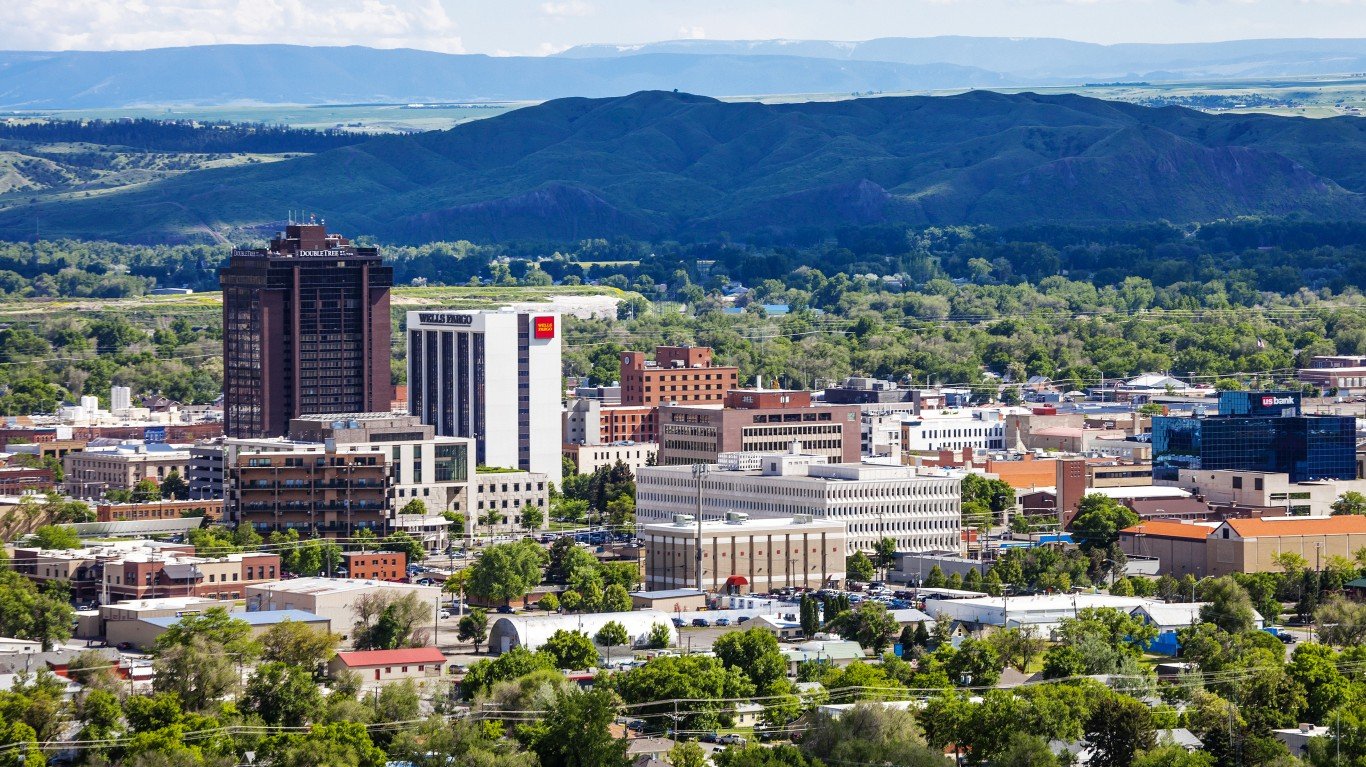
32. Montana
> Female earnings as pct. of male earnings: 80.7% (23rd lowest)
> Female life expectancy at birth: 81.1 years (25th lowest)
> Pct. legislative seats held by women: 31.3% (20th highest)
> Pct. mgmt. jobs held by women: 39.0% (7th lowest)
Female workers in Montana earn just 80.7% of what male workers do, one of the larger gender wage gaps among all states. State female workers have a median annual earnings of just over $40,000, one of the 10 lowest median incomes among states.
Montana is one of just six states with no state preschool program. State-funded early education programs help working females stay in the workforce by providing child care. Not having one of these programs can keep women from the workforce as child care costs can be a strain on families, particularly for single-parent households.

33. Georgia
> Female earnings as pct. of male earnings: 77.9% (11th lowest)
> Female life expectancy at birth: 79.7 years (13th lowest)
> Pct. legislative seats held by women: 32.6% (19th highest)
> Pct. mgmt. jobs held by women: 42.5% (15th highest)
Women in Georgia have among the worst health outcomes and the most significant economic challenges in the country. Georgia is one of just 13 states in which the female life expectancy at birth is under 80 years. Just 87.7% of women are insured, the fourth-lowest rate in the country. Female workers in Georgia have a median annual earnings over $5,000 less than the U.S. median, and the state’s gender wage gap is the 11th largest.
However, Georgia women do occupy a relatively high share of leadership positions within the state. Women hold 32.6% of state legislative seats, 2 percentage points higher than the average nationwide. Also, 42.5% of management jobs are held by women, the 15th highest share among all states.

34. Kentucky
> Female earnings as pct. of male earnings: 76.8% (6th lowest)
> Female life expectancy at birth: 77.9 years (3rd lowest)
> Pct. legislative seats held by women: 26.8% (17th lowest)
> Pct. mgmt. jobs held by women: 41.7% (22nd highest)
Kentucky has the third-lowest median annual earnings for female workers, at $38,324. This is $8,000 less than the median for all U.S. women. The state also has one of the largest gaps between male and female earnings, at 76.8%.
A college education is a good way to increase earning potential, but women in Kentucky are relatively unlikely to hold a degree. Just 26.4% of Kentucky women 25 and older hold at least a bachelor’s degree, the fourth-lowest share among all states. Nationwide, 33.9% of women that age hold at least a bachelor’s degree.
[in-text-ad-2]

35. Ohio
> Female earnings as pct. of male earnings: 81.9% (22nd highest)
> Female life expectancy at birth: 79.3 years (12th lowest)
> Pct. legislative seats held by women: 31.1% (21st highest)
> Pct. mgmt. jobs held by women: 40.8% (19th lowest)
Ohio is one of a dozen states in which fewer than 30% of women 25 and older hold at least a bachelor’s degree. College degrees can help boost earning potential, and female workers in Ohio have a median annual earnings of $44,824 – about $1,500 less than the U.S. median for all female workers.
Ohio women have the 12th lowest life expectancy at birth among states, at 79.3 years. The state is also one of just 16 states that do not offer paid sick leave, paid family leave, or expanded eligibility for family planning services coverage under Medicaid.

36. Alabama
> Female earnings as pct. of male earnings: 80.9% (24th lowest)
> Female life expectancy at birth: 78.0 years (4th lowest)
> Pct. legislative seats held by women: 15.7% (2nd lowest)
> Pct. mgmt. jobs held by women: 41.6% (24th highest)
Alabama women have among the worst health outcomes of all states. Women have a life expectancy at birth of 78.0 years, the fourth-lowest of all states. The state also has the third-highest infant mortality rate, at 7.7 deaths per 1,000 live births. It also has a relatively low share of women who are insured, at 91.4%. Nationwide, 91.8% of women have health insurance.
Female leadership in Alabama is a mixed bag, as just 15.7% of legislature seats are held by women. This makes Alabama one of just two states in which fewer than one in six legislators are female. Yet the state’s governor, Kay Ivey, is one of two female governors in Alabama history. Women hold 41.6% of management jobs in the state, slightly higher than the 41.4% rate nationwide.
[in-text-ad]

37. West Virginia
> Female earnings as pct. of male earnings: 81.5% (24th highest)
> Female life expectancy at birth: 77.3 years (the lowest)
> Pct. legislative seats held by women: 11.9% (the lowest)
> Pct. mgmt. jobs held by women: 43.4% (8th highest)
Just 11.9% of West Virginia state legislators are female. This is by far the lowest share of any state and less than half the national rate of 30.6%. West Virginia has never had a female governor, either. However, 43.4% of management jobs in the state are held by women, the eighth-highest share of all states.
West Virginia women also have the lowest life expectancy at birth of any state, at just 77.3 years – nearly four years lower than the nationwide life expectancy for women. Though the state’s gender wage gap is roughly in line with the gap nationwide, West Virginia’s female workers have among the lowest median annual earnings, at $38,428.

38. Oklahoma
> Female earnings as pct. of male earnings: 79.9% (19th lowest)
> Female life expectancy at birth: 78.2 years (7th lowest)
> Pct. legislative seats held by women: 21.5% (8th lowest)
> Pct. mgmt. jobs held by women: 41.7% (23rd highest)
Oklahoma has one of the most utilized and best funded pre kindergarten systems in the country. The state spends an average of $9,404 per preschool student, the eighth-highest total, and 38% of 3- and 4-year-olds in the state are enrolled in state preschool – tied for the second-highest rate.
However, Oklahoma’s health outcomes and leadership measures for women are among the worst in the country. Women in the state have a life expectancy at birth of 78.2 years, three years lower than the national average. Also, just 86.6% of women in the state have health insurance, the second-lowest rate in the country.

39. Arkansas
> Female earnings as pct. of male earnings: 84.1% (14th highest)
> Female life expectancy at birth: 78.2 years (7th lowest)
> Pct. legislative seats held by women: 22.2% (10th lowest)
> Pct. mgmt. jobs held by women: 41.9% (19th highest)
Arkansas has a relatively small gender wage gap. Median annual earnings of female workers in the state are 84.1% of the median for male workers. The nationwide gender wage gap is 82.3%. Yet most of Arkansas’ female workers earn less than $40,100, well below the U.S. median earnings for all female workers.
Less than a quarter of Arkansas state legislative seats are held by women, at 22.2%. This is the 10th lowest share among all states. The state has also never had a female governor. Arkansas also has the seventh-lowest female life expectancy at birth, at 78.2 years – three years lower than the median nationwide.
[in-text-ad-2]
40. Missouri
> Female earnings as pct. of male earnings: 78.7% (13th lowest)
> Female life expectancy at birth: 79.3 years (12th lowest)
> Pct. legislative seats held by women: 25.9% (14th lowest)
> Pct. mgmt. jobs held by women: 42.7% (11th highest)
Missouri ranks as one of the worst states for women in large part because of its relatively poor health outcomes for female residents. It is tied for the 12th lowest female life expectancy at birth, at 79.3 years. It is one of just 16 states that do not offer paid sick leave, paid family leave, or expanded eligibility for family planning services coverage under Medicaid.
Women in Missouri also face steeper economic challenges than women in most other states. Female workers earn 78.7% of what male workers do, the 13th widest gender wage gap, with a median annual earnings of just under $42,000.
41. South Carolina
> Female earnings as pct. of male earnings: 77.6% (9th lowest)
> Female life expectancy at birth: 79.3 years (12th lowest)
> Pct. legislative seats held by women: 17.6% (6th lowest)
> Pct. mgmt. jobs held by women: 40.8% (16th lowest)
South Carolina ranks as the 10th worst state for women partly because of the relatively low share of women holding leadership roles. Just 17.6% of legislative seats are held by women, compared to 30.6% nationwide. At 40.8%, South Carolina also has a relatively low share of management jobs held by female workers.
South Carolina has the ninth-largest gender wage gap, as female workers in the state earn just 77.6% of what male workers do. A college degree can help boost earning potential, yet just 30.3% of women 25 and older in South Carolina hold at least a bachelor’s degree, well below the 33.9% bachelor’s degree attainment rate for all women that age nationwide.
[in-text-ad]
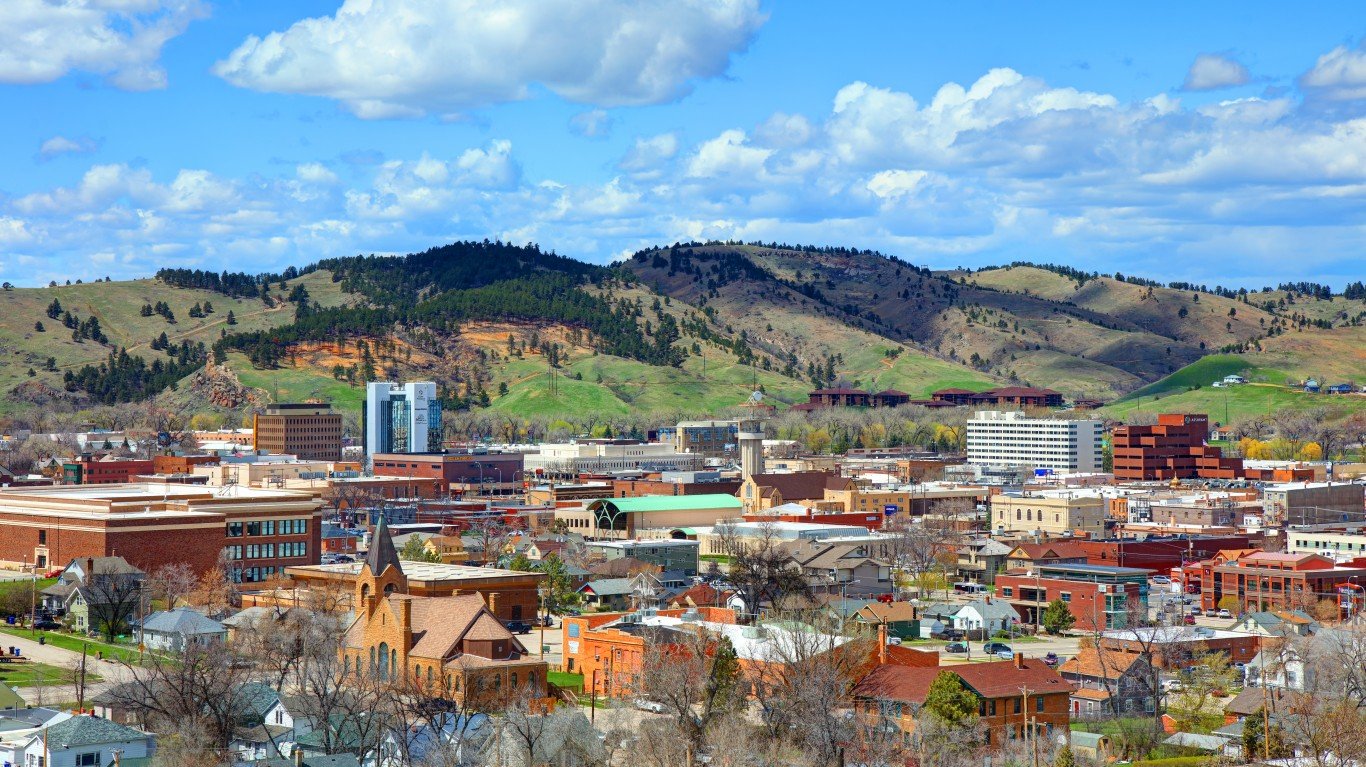
42. South Dakota
> Female earnings as pct. of male earnings: 85.1% (10th highest)
> Female life expectancy at birth: 81.4 years (20th highest)
> Pct. legislative seats held by women: 27.6% (18th lowest)
> Pct. mgmt. jobs held by women: 34.7% (2nd lowest)
South Dakota has a relatively small gender wage gap, with female workers earning just over 85% of male earnings, above the national average gender wage gap. However, the state’s median annual earnings for female workers is relatively low, at $41,444. The U.S. median annual earnings for all female workers is $46,332. South Dakota is also one of just six states that does not offer any state preschool program.
Though South Dakota has a female governor, Kristi Noem, the state still has a relatively low share of women in leadership roles. Just 27.6% of legislative seats are held by women, compared to 30.6% nationwide. It also has the second lowest share of management jobs held by women, at 34.7%.

43. Utah
> Female earnings as pct. of male earnings: 72.7% (the lowest)
> Female life expectancy at birth: 81.5 years (17th highest)
> Pct. legislative seats held by women: 24.0% (11th lowest)
> Pct. mgmt. jobs held by women: 35.7% (4th lowest)
Utah ranks as one of the worst states for women, largely for financial reasons. The state has by far the largest gender wage gap of any state, as the median annual earnings of women in the state of just $40,664 is just 72.7% of what male workers in the state earn. The median earnings of female state workers is also well below the $46,332 median annual earnings across all U.S. women.
Women also control a relatively low share of managerial and political power in the state. Less than a quarter of seats in the state legislature are held by women, compared to 30.6% of all seats nationwide. Utah also has the fourth-lowest share of management jobs held by women, at 35.7%. Nationwide, women hold 41.4% of management jobs.

44. Tennessee
> Female earnings as pct. of male earnings: 81.8% (23rd highest)
> Female life expectancy at birth: 78.1 years (5th lowest)
> Pct. legislative seats held by women: 16.7% (5th lowest)
> Pct. mgmt. jobs held by women: 41.5% (25th lowest)
Tennessee ranks as one of the worst states for women in large part because of the poor health outcomes for women in the state. Tennessee women have the fifth-lowest life expectancy at birth of any state at 78.1 years – more than three years lower than the average life expectancy nationwide. It is one of just 16 states that do not offer paid sick leave, paid family leave, or expanded eligibility for family planning services coverage under Medicaid.
Though the share of management jobs in Tennessee held by women is roughly in line with the national figure, women still lack leadership roles in the state, as just 16.7% of state legislature seats are held by women. The state has never had a female governor.
[in-text-ad-2]

45. Louisiana
> Female earnings as pct. of male earnings: 74.2% (2nd lowest)
> Female life expectancy at birth: 78.5 years (8th lowest)
> Pct. legislative seats held by women: 18.1% (7th lowest)
> Pct. mgmt. jobs held by women: 43.1% (9th highest)
Louisiana is one of just two states in which the median annual earnings for female workers is less than 75% of the median for male workers. Most female workers in the state earn less than $40,000 per year. This is despite the fact that 43.1% of management jobs in Louisiana are held by women, one of the 10 highest shares in the country.
Louisiana has some of the worst health outcomes for women in the country. The female life expectancy at birth is just 78.5 years, the eighth-lowest expectancy among all states. Louisiana also has the second-highest infant mortality rate in the country, at almost 8.0 deaths per 1,000 live births.

46. North Dakota
> Female earnings as pct. of male earnings: 79.9% (18th lowest)
> Female life expectancy at birth: 81.7 years (12th highest)
> Pct. legislative seats held by women: 22.0% (9th lowest)
> Pct. mgmt. jobs held by women: 31.2% (the lowest)
North Dakota ranks as one of the worst states for women in large part because women hold a very small share of the leadership positions in the state in both the public and private sector. Just 22.0% of legislative seats are held by women, one of the lowest shares among all states. Also, just 31.2% of management level jobs are held by women, the absolute lowest share of any state.
North Dakota has a relatively large gender wage gap, as women make less than 80% of what men do, one of the widest gaps in the country. Though the state has a relatively high female life expectancy at birth of 81.7 years, not all health indicators are positive. North Dakota’s infant mortality rate is the fourth highest in the country, with 7.5 infant deaths per 1,000 live births.
[in-text-ad]

47. Idaho
> Female earnings as pct. of male earnings: 75.7% (4th lowest)
> Female life expectancy at birth: 81.3 years (22nd highest)
> Pct. legislative seats held by women: 30.5% (25th highest)
> Pct. mgmt. jobs held by women: 36.5% (6th lowest)
The median annual earnings for a female worker in Idaho is $38,012 – the second-lowest median of all states and more than $8,000 lower than the national median. The state has the fourth-largest gender wage gaps in the country, with female workers earning just 75.7% of what male workers do.
Women also hold a low share of leadership positions in Idaho. Just 36.5% of management jobs are held by women, nearly 5 percentage points lower than the share nationwide. The state’s legislature is made up of 30.5% female legislators, just slightly lower than the nationwide rate. Idaho has never had a female governor.
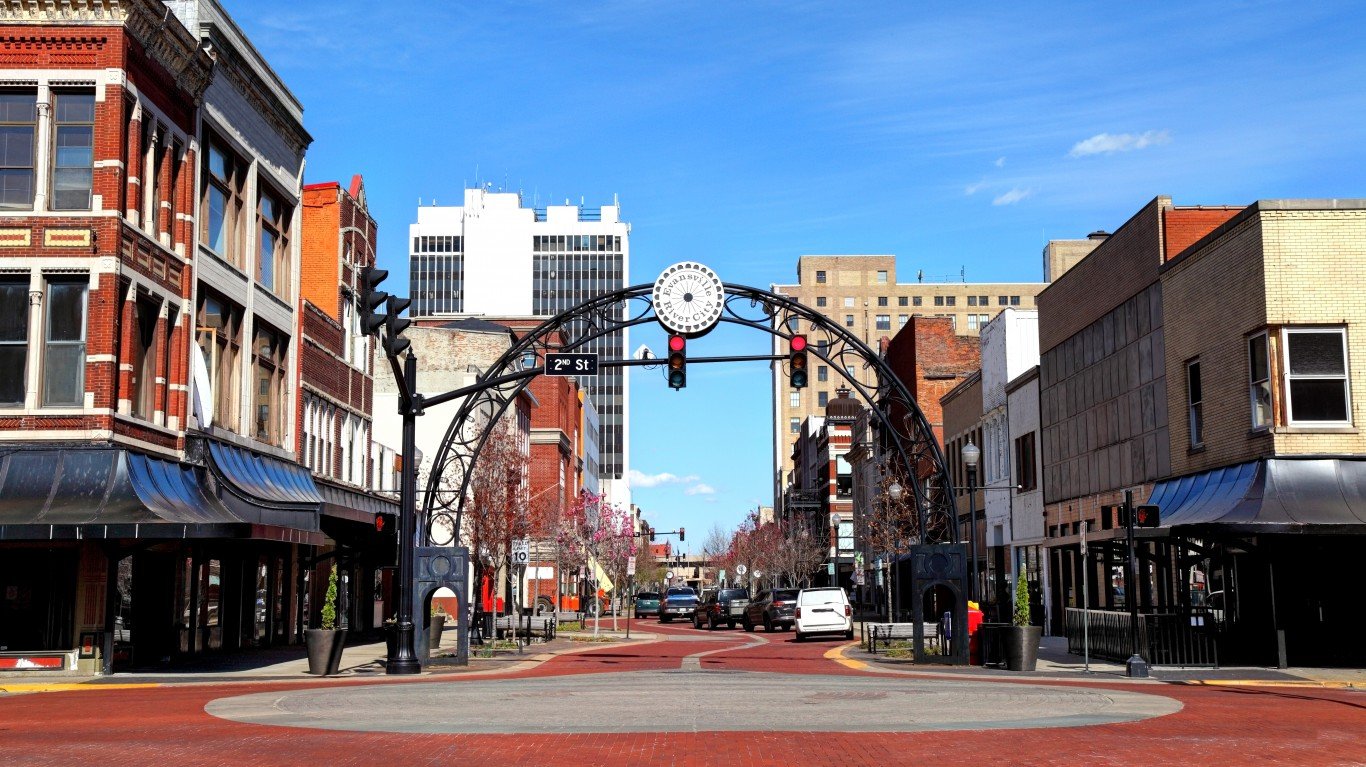
48. Indiana
> Female earnings as pct. of male earnings: 77.0% (8th lowest)
> Female life expectancy at birth: 79.3 years (12th lowest)
> Pct. legislative seats held by women: 26.0% (15th lowest)
> Pct. mgmt. jobs held by women: 39.8% (11th lowest)
Indiana ranks as one of the worst states for women in nearly every economic, leadership, and health measure. The state’s female life expectancy at birth is 79.3 years, almost two full years lower than the life expectancy nationwide.
Female workers in Indiana have a median annual earnings of almost $5,000 less than the median nationwide. The state also has one of the largest gender wage gaps, as female workers earn just 77% of what male workers do.
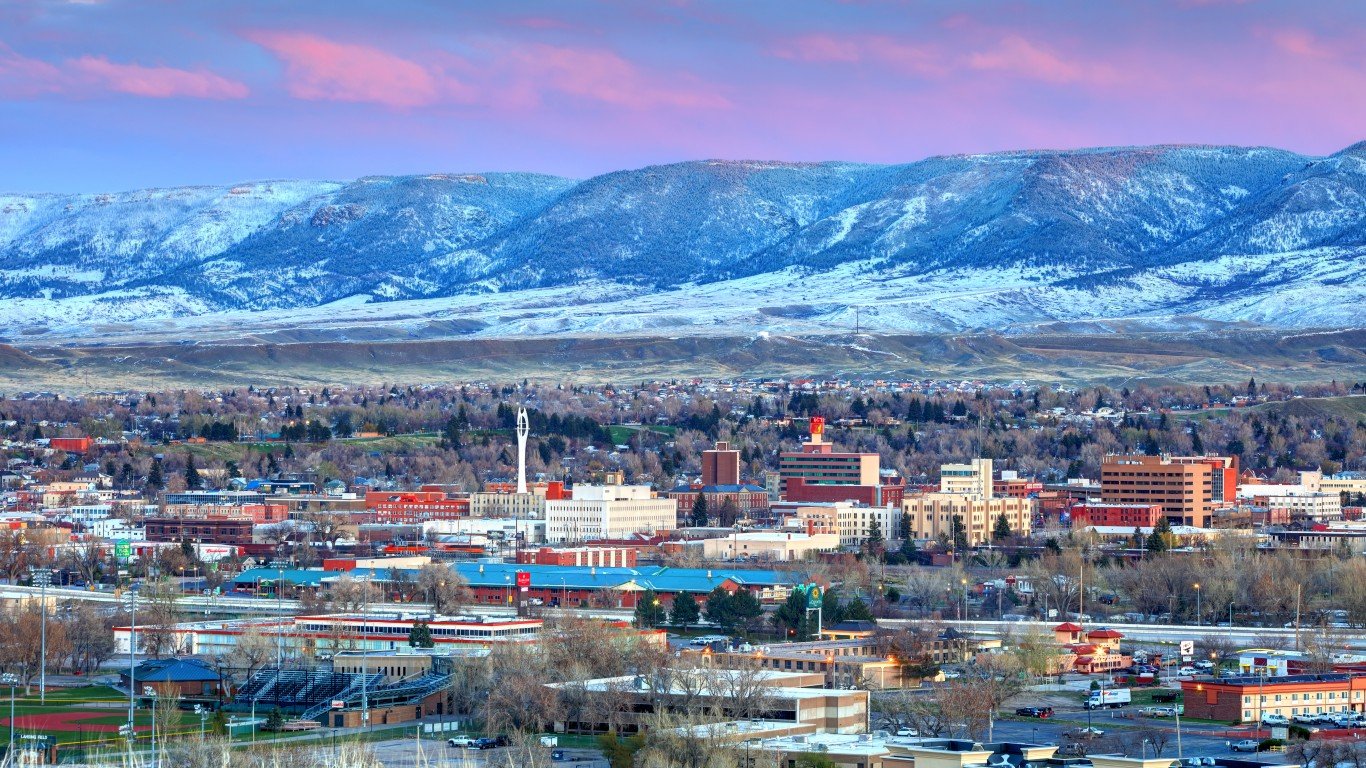
49. Wyoming
> Female earnings as pct. of male earnings: 75.2% (3rd lowest)
> Female life expectancy at birth: 80.3 years (18th lowest)
> Pct. legislative seats held by women: 16.7% (5th lowest)
> Pct. mgmt. jobs held by women: 41.3% (22nd lowest)
Wyoming ranks as the second-worst state for women in large part because of the economic disparities between men and women in the state. Female workers make roughly three-quarters of what male workers do. With a median annual earnings of $41,340, female workers in Wyoming earn about $5,000 less than what female workers around the country earn.
Wyoming is also one of just a handful of states with no state preschool program, which can make life more difficult for working parents. Women also have a relatively low share of leadership positions in Wyoming. Just 16.7% of state legislature seats are held by women.
[in-text-ad-2]

50. Mississippi
> Female earnings as pct. of male earnings: 76.9% (7th lowest)
> Female life expectancy at birth: 77.5 years (2nd lowest)
> Pct. legislative seats held by women: 16.7% (5th lowest)
> Pct. mgmt. jobs held by women: 42.6% (13th highest)
Mississippi ranks as by far the worst state in the country for women. Its female workers have median annual earnings of $35,100 – the lowest in the country. This median is also just 76.9% of what men in the state earn, the seventh largest gender wage gap among states. College degrees can help bolster earnings, but Mississippi is one of three states in which fewer than a quarter of women 25 and older have at least a bachelor’s degree.
Mississippi has by far the highest infant mortality rate of any state, at 8.7 deaths per 1,000 live births. No other state has a rate of even 8.0 per 1,000 births, and the nationwide rate is 5.6 deaths per 1,000 births. The state also has the second-lowest life expectancy at birth for female residents, at 77.5 years.
Methodology
To determine the worst states for women, 24/7 Wall St. developed an index composed of 15 metrics measuring economy, health, and leadership in all 50 states.
In the economy section, data on the median annual earnings for full-time female workers came from the U.S. Census Bureau’s 2019 American Community Survey and was included in the index at full weight. Data on median female earnings as a percentage of median male earnings were calculated using 2019 ACS data and were included in the index at full weight. Data on the percentage of the female population 25 years and over with at least a bachelor’s degree came from the 2019 ACS and was included in the index at full weight. Data on the total state and local spending in fiscal 2020 per child enrolled in preschool came from the National Institute for Early Education Research and was included in the index at full weight. Finally, data on the percentage of 3- and 4-year-olds enrolled in state prekindergarten in fiscal 2020, also from the NIEER, was included in the index at full weight.
In the health section, data on female life expectancy at birth as of 2018 came from the Centers for Disease Control and Prevention and was included in the index at full weight. Data on the number of infant deaths per 1,000 live births in 2019 also came from the CDC and was included in the index at full weight. Data on the percentage of the female civilian noninstitutionalized population with health insurance came from the 2019 ACS and was included in the index at full weight. Finally, the binaries of whether a state has paid sick leave laws, paid family and medical leave laws, and whether the state has expanded eligibility for coverage of family planning services under Medicaid were all included in the index at one-fourth weight.
In the leadership section, data on the number of female legislators as a percentage of the number of seats in a state legislature in 2021, compiled by the National Conference of State Legislatures, was included in the index at full weight. The number of female governors throughout a state’s history, compiled by the Center for American Women and Politics of Rutgers University, was included in the index at one-fourth weight. The binary of whether a state currently has a female governor, as of January 2022, was included in the index at one-fourth weight. Finally, data on the percentage of the female civilian population 16 and over employed in management occupations, from the 2019 ACS, was included in the index at full weight.
Data was compiled January 2022. All data is for the most recent period available.
Sponsored: Find a Qualified Financial Advisor
Finding a qualified financial advisor doesn’t have to be hard. SmartAsset’s free tool matches you with up to 3 fiduciary financial advisors in your area in 5 minutes. Each advisor has been vetted by SmartAsset and is held to a fiduciary standard to act in your best interests. If you’re ready to be matched with local advisors that can help you achieve your financial goals, get started now.
Thank you for reading! Have some feedback for us?
Contact the 24/7 Wall St. editorial team.

 24/7 Wall St.
24/7 Wall St.